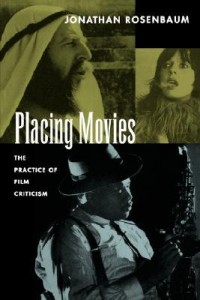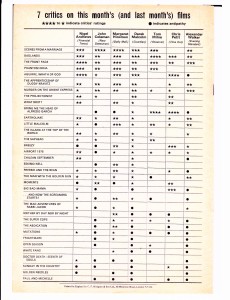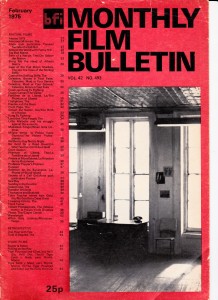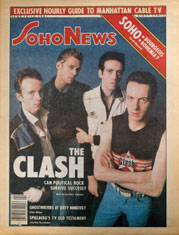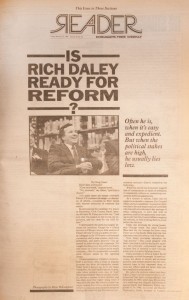This is the Introduction to the second section of my first collection, Placing Movies: The Practice of Film Criticism (University of California Press, 1993). I’ve taken the liberty of adding a few links to some of the pieces of mine mentioned here which appear on this web site.
My original title for this section of the book was “Masterpieces,” but the editor, Ed Dimendberg, who had a much better sense of what was academically acceptable than I did, got me to change it to “Touchstones”. For the record, I still think that “Masterpieces” is better. — J.R.
It seems to me that one of the most underrated elements in criticism is quite simply information — relevant facts deriving from research — and how this is imparted to the reader in relation to other elements. Thanks to the prestige of theory in academia and the equally valued role played by rhetoric in journalistic criticism, facts often seem to be held in relatively low esteem in critical writing nowadays, but as long as criticism aspires to be a vehicle for discovery, it seems to me that research should play a much larger role than it normally does. I bring this matter up because the value of the information imparted in all the pieces in this section seems to me inextricably tied to what I have to say about these films, and my analyses would be appreciably different without it — a factor that is probably most obvious when it comes to GERTRUD and OTHELLO.*
________________________________________________________________ *The review of the latter film — like the separate Welles essay in the next section — represents one of the many “spinoffs” of the long-term research that went into editing This Is Orson Welles by Welles and Peter Bogdanovich (HarperCollins, 1992). A few remarks about the “restored” OTHELLO have been revised and updated to incorporate facts gleaned from other sources after the piece was originally written. Two afterthoughts that I haven’t been able to incorporate are my neglect of the role played by Alberto Barberis in composing the original OTHELLO score — about which I still have no information, apart from his screen credit—and the lamentable release version of Welles’s unfinished DON QUIXOTE prepared by Jesus Franco, which I have since seen in both its Spanish and English versions. Regrettably, this is a hodgepodge that seems even more questionable than the “restored” OTHELLO, in sound as well as image — at least on the basis of the portions of the original edited footage that I saw in New York in 1988 — but in the absence of information concerning how or why Franco made most of his choices, further analysis at this stage would be premature.
Sometimes information is simply a matter of observation. One of the critical commonplaces about THE SAGA OF ANATAHAN is that everything in the film with the exception of the ocean waves is artificial and created, and Sternberg has often been uncritically quoted as saying that the only thing he regretted in the film were these waves, precisely because they were not of his making. But to accept this statement is to ignore one of the key sequences in the film — the newsreel segment of Japanese soldiers returning home after the war — and to misconstrue the meaning of the artifice in the remainder of the film as a consequence.
The individual films discussed in this section don’t constitute a definitive list of favorites. For the record, I cherish Dreyer’s ORDET every bit as much as GERTRUD, and in many ways find the utopian poetry of Hawks’s THE BIG SKY as stirring as the galvanic star power of GENTLEMEN PREFER BLONDES. For all its conceptual and emotional purity, I’m not at all sure that ANATAHAN deserves to be called Sternberg’s best film. (Polemically speaking, some of my arguments on its behalf grew out of disagreements about it that I had with Manny Farber, Patricia Patterson, and Jean-Pierre Gorin in San Diego, where I was writing the piece; Manny, in particular, often cited THE DOCKS OF NEW YORK as the only Sternberg film he liked, and I can certainly see many qualifies in it that are utterly foreign to the strengths of ANATAHAN .) Many other favorite films — AU HASARD BALTHAZAR; TIH MINH; L’ANNÉE DERNIÈRE À MARIENBAD; PLAYTIME; OUT 1; CHIMES AT MIDNIGHT; BREATHLESS; SUNRISE; HALLELUJAH I’M A BUM; THE GREAT CONSOLER; TOO EARLY, TOO LATE; STALKER; THE TIGER OF ESCHNAPUR and THE INDIAN TOMB; CITY LIGHTS and MONSIEUR VERDOUX; LA NUIT DU CARREFOUR and THE RULES OF THE GAME; TALE OF THE LATE CHRYSANTHEMUMS and SANSHO THE BAILIFF; LA RÉGION CENTRALE and YEELEN ; among others — aren’t examined in this section at all.
***
The review from Monthly Film Bulletin that begins this section —written when I was working as assistant editor under Richard Combs — is not exactly representative of the 135 reviews and features I wound up writing for the magazine, many of which were short reviews of softcore sex films and other forgettable items that Richard and I couldn’t persuade any freelancers to cover. The job of the Bulletin was to run complete credits, detailed synopses, and reviews of every feature film released in England, along with a selection of the shorts — an agenda that has made it an indispensable reference source for many film scholars all over the world, because no other publication that has lasted as long has attempted anything comparable.
When I started work on the Bulletin, on issue number 488, it was in its forty-first year, and the entire staff of the magazine consisted of Richard and myself, working in an overcrowded office on 81 Dean Street down the hall from the equally tiny offices of Penelope Houston, which she shared with her secretary Sylvia Loeb, and David Wilson, her assistant editor on Sight and Sound. By the time I left almost two and a half years later, we had acquired a secretary (Sue Scott-Montcrieff) and had moved to a much larger office next door, which made things somewhat easier. But a substantial part of the work still consisted of researching and typing up credits, mainly of uninteresting films, a process that usually involved everything from looking up film titles on index cards at the BFI’s invaluable Information Department to lugging the first or last reels of various films to the BFI from nearby distributors on Dean or Wardour streets in order to go over them on movieolas. (Sometimes we even had to persuade projectionists after screenings to let us try to decipher the credits from individual film frames without such equipment.) And because we also had to list the lengths of films in numbers of feet before and after censor cuts — usually relying on the figures we got from the censor board and from certain distributors, but otherwise measuring the prints ourselves when this information was unavailable — a large amount of our work consisted of physically handling many of the films we were cataloguing.
Perhaps the most significant change that took place in the magazine during that period, a change in which I played some part, was substituting informational features on the back page for a monthly chart that polled the leading newspaper reviewers on the current releases in the fashion of Cahiers du Cinéma ‘s “Conseil des dix” during the 1950s and 1960s — that is, with rankings of one to four stars, or “bullets” (in the shape of black dots) to represent antipathy. I can recall that Alexander Walker of the Daily Telegraph, one of these reviewers, was dead set against this change because he was convinced that the Bulletin was a hotbed of leftist biases — something he complained about on a regular basis — and believed the chart was one of the only features in the magazine that reflected a wider range of political sentiments. Indeed, one of the issues that always seemed to swirl around the Bulletin as a state-supported journal was the question of information versus opinion. Some readers felt we should stick to credits and synopses and omit the reviews, to which I usually replied that neither credits nor synopses were as “objective” as most people pretended, and that information was always highly selective as well as subjective. (It’s a truism that official screen credits, especially in studio productions, can’t always be trusted as the ultimate source of who did what on a film — key screenwriters often go unmentioned, to cite only one example — and it’s equally evident that any synopsis subjectively privileges certain kinds of narrative information over other kinds.) With this in mind, the first back-page informational supplement, which I prepared myself, was a bibliography of interviews, scripts, and texts by Jean-Marie Straub and Danièle Huillet for the March 1976 issue, designed as a supplement to reviews of many of their films in the same issue. (Later, I did similar bibliographies for Jacques Rivette and Eric Rohmer.) If memory serves, the new feature didn’t lead to any cancellations of subscriptions — unlike my decision to feature a still from Michael Snow’s WAVELENGTH on the cover of the February 1975 issue, when I was briefly serving as deputy editor and decided to illustrate my own (belated) review of the film. And the informational supplements were later expanded and supplemented by critical articles some time after I returned to the states.
Ever since Penelope left Sight and Sound in late 1990, and the Bulletin became absorbed within the retooled Sight and Sound as a midsection in July 1991, still with Richard as editor (until his departure in late 1992), its continuing survival as an institution has become more precarious, especially now that Sight and Sound no longer has a guaranteed subscription list tied to membership in the BFI. (To commemorate the Bulletin ‘s last issue, its 687th, in April 1991, Richard selected an appropriately apocalyptic cover — a cataclysmic shootout that he ironically labeled “Redemption and resolution in THE GODFATHER PART III.”)
During my own tenure at the BFI, as well as before and afterward, the two magazines had very separate identities. Sometimes justly and sometimes unjustly, Sight and Sound was regarded in Britain as the voice of the literary establishment — so much so that most other British film journals from Movie to Screen largely defined themselves in opposition to its values of good writing, gentility, individual critical voices, and Penelope’s international tastes — a mixture of scrupulous editing and eclecticism that, all things considered, could be reasonably compared in certain respects to The New Yorker under the editorship of William Shawn. Whatever its limitations, I consider it the best film magazine in English I’ve ever written for, even if many of the pieces I wrote for Penelope largely reflected the influence of other magazines — including Cahiers du Cinéma, Screen, Movie, and Film Comment.
But the mythic and symbolic associations of the magazine within British film culture were so formidable that entire schools of thought within that culture were defined primarily by their opposition to it. Foremost among these schools was the BFI’s Education Department, which published Screen Education and had significant links to Screen, and the uniqueness of my position in the Editorial Department at the time was the fact that I was the only one who fraternized on occasion with members of this other group. A good sense of how divided the two factions were becomes clear if one looks at all the bibliographies in The Cinema Book, edited by Pam Cook — the veritable Bible of the Education Department’s idées reçus during this period — which systematically omit everything ever published in Sight and Sound as a matter of course. (My principal point of contention with the Education Department’s philosophy was its dependence on film clips as the be-all and end-all of film education; I was often shocked to discover how many film teachers “taught” GENTLEMEN PREFER BLONDES, for instance, without having ever seen the entire movie.)
The Bulletin, by contrast, was never considered part of “the establishment” and was respected by many English critics who shunned Sight and Sound. As one token of this difference, I regarded it as something of a coup when I persuaded Ben Brewster, the editor of Screen at the time, to review Ozu’s EARLY SPRING for the Bulletin in 1976. The fact that Ben had taught himself Japanese was enormously helpful in compiling the credits, but his unwillingness to compose a Bulletin-style synopsis, choosing instead to give a detailed account of every scene in the film — a refusal I felt some theoretical sympathy for, given my own lack of skill in this form of Bulletinese — sadly prevented this experiment from having any sequels.
***
It seems worth noting that the first item in this section, as well as the last two, were written as a staff reviewer, whereas the pieces on ANATAHAN, GERTRUD, and GENTLEMEN PREFER BLONDES were all written as a freelancer. I bring this up because the latter three pieces came about through specific circumstances that probably wouldn’t have existed if I had been a staff writer at the time. I wrote the ANATAHAN piece after booking the film for a course at University of California, San Diego; I was sharing a house at the time with Louis Hock, an experimental filmmaker who owned a 16-millimeter projector that he was able to hook up to my stereo. I wound up recording the sound track on audiocassettes (this was in 1977, before I knew about VCRs), a technique I was to employ even more systematically a little later on with ON MOONLIGHT BAY for my book Moving Places, and I’m sure my analysis would have been substantially different without this procedure. (Ed Dimendberg, my editor on this book, rightly points out that my account of the film’s visuals is skimpy, to say the least.) What I hadn’t realized at the time was that the version I was writing about, booked from Twyman Films, was a recent “restoration” of the film done by Sternberg’s widow — a term I place in quotes because the new version involved a few visual and aural additions to the original. Some film scholars, Bernard Eisenschitz in particular, have raised objections to these additions, which consist of a few nude shots of the actress playing Keiko and some modifications in the sound mix. I haven’t been able to research this matter independently, but it seems reasonable to assume that any posthumous “improvements” made on films like this one and on Welles’s OTHELLO should be approached skeptically, though they rarely are by critics — myself included, in this case.
My article on GENTLEMEN PREFER BLONDES grew out of four particular sources: my fascination with the relationships between the songs in the movie, which dated back to notes taken during my days in Paris; my preoccupation with 1950s ideology, which had already been a major focus of Moving Places; my interest in Richard Dyer’s remarks about Monroe’s contradictory Lorelei Lee in his book Stars; and my piece on Barthes that is reprinted in the previous section. Originally, the Barthes piece was designed to be run with my translation of a brief, early piece by Barthes (“Au Cinemascope,” originally published in Les Lettres Nouvelles, February 1954). To my frustration, after Sight and Sound secured the rights to run this piece, they wound up omitting it due to lack of space; but because Barthes’s three paragraphs seemed relevant to my ideas about GENTLEMEN PREFER BLONDES, I wound up recycling portions of them in this article two years later. In the course of all these transactions, I somehow managed to suppress a key childhood memory that reemerged long after this piece was published — a memory that serves to explain quite apart from my labyrinthine arguments why so many people associate this 1953 movie with CinemaScope. For an early CinemaScope test reel that I had actually seen at an exhibitors convention in Atlanta with my father that spring, one of the sequences shown was the “Diamonds Are a Girl’s Best Friend” number reshot in that format. (Whether or not Hawks was around for this reshooting is something I’ve been unable to uncover.)
The piece in this section that required the most work and took the longest was the one on GERTRUD. This entailed acquiring and reading not only Drouzy’s biography in French, but also a copy of the script in French that contained the suppressed intertitles, as well as much rummaging around in several libraries until I finally located the original play in French at the New York Public Library. The latter two discoveries were both related in part to certain quarrels I had with the chapter on GERTRUD in David Bordwell’s fascinating and generally brilliant book on Dreyer. (The first of these quarrels was aired in a review of the book in Film Comment, written well before I discovered the play.)
Ironically, the impulse that first moved me to write about GERTRUD — no trace of which remains in the final piece — was a desire a decade earlier to respond to a point made about the very limited use of “reverse-field” cutting in the film by Noël Burch and Jorge Dana in their article “Propositions” (Afterimage [London], no. 5, Spring 1974). Burch and Dana observed that this form of cutting occurred only very early and very late in the film — when Gertrud tells her husband that she loves someone else and when she says goodbye to her friend Axel in the final scene. The point I wanted to argue was that this was the only time during the film that real communication took place between two people, which was why I thought Dreyer privileged the technique in this fashion. But by the time I finally got around to writing the piece, so many other concerns had intervened that I never got around to propounding my original argument.
When I first proposed this article to Penelope at Sight and Sound, she was dubious about there being anything more to say about GERTRUD, and I’m grateful to John Pym — who succeeded David Wilson as her assistant after succeeding me on the Bulletin — for changing her mind.
Another significant contrast in this section can be found in the pieces done for Sight and Sound and Film Comment and those done for a less specialized and more mainstream readership in the Chicago Reader. I tend to think that my belated requirement to communicate with people other than film buffs on this weekly (and, earlier, on Soho News) has helped my writing — especially at the Reader, where I’ve been edited much more, and where my editors, none of them hardcore film buffs, are always the first people I have to address.

